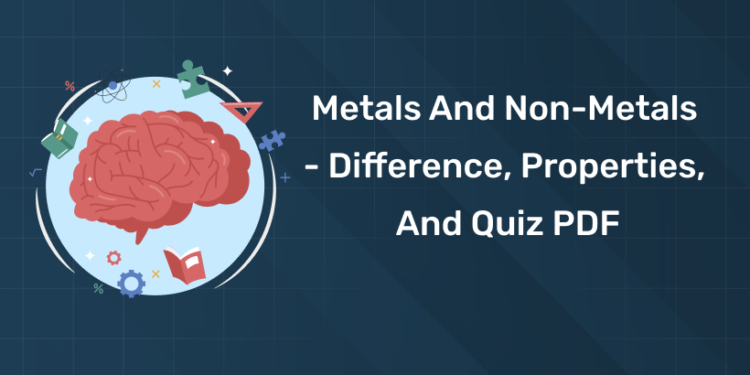Table of Contents
Introduction
Metals and non metals are the base of our world, they are part of everything from infrastructure to the devices we use daily. Whether it’s the steel in skyscrapers or the oxygen we breathe, both have different properties that distinguish them. Understanding the difference between metals and non metals is important not only for science students but for anyone curious about the building blocks of matter. In this post we will go through the main differences and properties of metals and non metals and then a quiz to test your knowledge.
Metals and Non-Metals Difference
1: Who was the first woman President of India?
The simplest difference between metals and non metals is in their physical and chemical properties. Here are the main differences:
-
Physical Appearance
- Metals: Shiny, has metallic lustre. Most metals are solid at room temperature (except mercury), so they look robust and heavy.
- Non-Metals: Dull in appearance and can be solid, liquid or gas at room temperature. For example sulphur (solid), bromine (liquid), nitrogen (gas) are all non metals.
-
Conductivity
- Metals: Good conductors of heat and electricity due to free movement of electrons in their structure. This property makes them suitable for electrical wiring and cooking utensils.
- Non-Metals: Poor conductors of heat and electricity, they don’t have free electrons. Non metals like plastic are used as insulators in electrical circuits.
-
Malleability and Ductility
- Metals: Highly malleable and ductile, can be hammered into thin sheets (malleable) or drawn into wires (ductile). This property makes metals essential in construction and manufacturing.
- Non-Metals: Brittle when solid and can’t be drawn into wires or hammered into sheets without breaking. They crumble under force rather than bend.
-
Density and Strength
- Metals: Dense and strong, so used in heavy machinery and buildings. For example iron and steel are used to build cars and structures due to their strength.
- Non Metals: Less dense and generally weaker than metals. Non metals are used in lightweight applications like plastics or gases.
-
Reaction with Oxygen
- Metals: React with oxygen to form metal oxides which are generally basic in nature. For example when iron reacts with oxygen it forms iron oxide, commonly known as rust.
- Non-Metals: React with oxygen to form non metal oxides which are acidic in nature. For example sulphur reacts with oxygen to produce sulphur dioxide, an acidic gas.
-
Sonority
- Metals: Metals produce ringing sound when struck, so they are sonorous. This property is why metals are used in bells and musical instruments.
- Non-Metals: Non sonorous, they don’t produce sound when struck.
So now you know the difference between metals and non metals. This helps you understand why they are used in different industries and applications.
Differences Between Metals And Non-metals
A reactivity series is a vital tool for chemists. It helps us to understand the properties of metals and the differences between them.
| Metals | Non Metals |
|---|---|
| These are solids at room temperature except mercury | These exist in all three states |
| These are very hard except sodium | These are soft except diamond |
| These are malleable and ductile | These are brittle and can break down into pieces |
| These are shiny | These are non-lustrous except iodine |
| Electropositive in nature | Electronegative in nature |
| Have high densities | Have low densities |
Free UPSKILLING Courses!
Take your first step toward mastering in-demand skills, acing interviews, and securing top-tier jobs with Entri's free upskilling courses.
Start Learning!Metals and Non-Metals Properties
Now let’s dive deeper into the properties of metals and non-metals:
- Properties of Metals
- Electrical Conductivity: Metals like copper and aluminium are used in electrical wiring because they are good conductors.
- Thermal Conductivity: Metals can conduct heat quickly which is why they are used in cooking pots and pans.
- Shiny: Metals have a reflective surface so they look good and are used in jewellery.
- High Melting and Boiling Points: Metals can withstand high temperatures so they are used in construction and heavy machinery.
- Corrosion Resistance: Some metals like gold and platinum don’t react with air or water and are corrosion resistant.
- Sonorous: As mentioned earlier metals produce sound when struck which is used in making musical instruments and bells.
- Properties of Non-Metals
- Poor Conductors of Heat and Electricity: Non-metals like rubber and plastic are used as insulators in electrical wiring and appliances.
- Brittleness: Non-metals break when pressure is applied which is why they are not used in heavy duty applications.
- Low Melting and Boiling Points: Most non-metals have lower melting and boiling points than metals.
- Non-Sonorous: Non-metals don’t produce sound when hit.
- Form of Matter: Non-metals can exist in all three states of matter—solid (e.g. sulphur), liquid (e.g. bromine), gas (e.g. oxygen).
- Reactivity with Oxygen: Non-metals form acidic oxides when they react with oxygen, e.g. carbon dioxide (CO2) and sulphur dioxide (SO2).
Applications of Metals and Non-Metals
Both metals and non-metals have many applications in different sectors because of their properties. Here are some examples:
Metals:
- Used in construction for beams, girders and nails.
- Used in electrical appliances and wires.
- Used in automobiles and airplanes.
- Used in jewellery industry for making gold, silver and platinum ornaments.
Non Metals:
- Fertilizers use non-metals like nitrogen and phosphorus.
- Respiration and industrial processes use oxygen.
- Industries use sulphur to make sulphuric acid, one of the most important industrial chemicals.
- Balloons use non-metal gases like helium, and advertising signs use neon.
Summary
In short, metals and non-metals are the building blocks of matter and are used in daily life, industrial applications and environment. Their properties—electrical conductivity, malleability and reactivity—make them suitable for different tasks from building skyscrapers to insulating electrical wires. Students, professionals and anyone interested in the materials that make up our world should know these differences.
Download the Mock Test Preparation App for Free
Free UPSKILLING Courses!
Take your first step toward mastering in-demand skills, acing interviews, and securing top-tier jobs with Entri's free upskilling courses.
Start Learning!Metals and Non-Metals Quiz
If you’re looking to test your knowledge, the quiz below will help reinforce your understanding of the topic. PDF quiz has been developed by us to assess your comprehension of the subject matter.
1.Which of the following is a property of metals?
a) Poor conductor of heat
b) Malleable
c) Brittle
d) Low melting point
Answer: b) Malleable
2. Which of the following is a non metal?
a) Copper
b) Sulphur
c) Aluminium
d) Zinc
Answer: b) Sulphur
3. Metals react with oxygen to form:
a) Acidic oxides
b) Basic oxides
c) Neutral oxides
d) None of the above
Answer: b) Basic oxides
4. Which property is NOT a characteristic of non metals?
a) Low conductivity
b) Brittle
c) High density
d) Low melting and boiling points
Answer: c) High density
5. What is the state of mercury at room temperature?
a) Solid
b) Liquid
c) Gas
d) Plasma
Answer: b) Liquid
6. Which metal is used in making electrical wires due to its high conductivity?
a) Zinc
b) Iron
c) Copper
d) Lead
Answer: c) Copper
7. Non-metals typically react with oxygen to form:
a) Basic oxides
b) Acidic oxides
c) Salts
d) Neutral oxides
Answer: b) Acidic oxides
8. Which of the following is a poor conductor of electricity?
a) Iron
b) Silver
c) Plastic
d) Aluminium
Answer: c) Plastic
9. Which property allows metals to be hammered into thin sheets?
a) Ductility
b) Malleability
c) Conductivity
d) Sonority
Answer: b) Malleability
10. What is the property of metals that allows them to be drawn into wires?
a) Hardness
b) Brittleness
c) Ductility
d) Conductivity
Answer: c) Ductility
11. Which of the following is NOT a use of non metals?
a) Insulation in electrical wires
b) Building materials
c) Fuel combustion
d) Fertilizers
Answer: b) Building materials
12. Metals are generally:
a) Dull in appearance
b) Poor conductors of heat
c) Sonorous
d) Brittle
Answer: c) Sonorous
13. Non metals that are gaseous at room temperature include:
a) Nitrogen
b) Magnesium
c) Iron
d) Silver
Answer: a) Nitrogen
14. Which of the following metals is the least reactive?
a) Potassium
b) Sodium
c) Gold
d) Magnesium
Answer: c) Gold
15. Which non-metal is essential for respiration?
a) Carbon
b) Oxygen
c) Nitrogen
d) Phosphorus
Answer: b) Oxygen
16. What is the main component of steel?
a) Copper
b) Iron
c) Zinc
d) Aluminium
Answer: b) Iron
17. Which of the following is NOT a physical property of non-metals?
a) Poor conductivity
b) Ductility
c) Brittle when solid
d) Low density
Answer: b) Ductility
18. The oxide formed when carbon reacts with oxygen is:
a) Carbon monoxide
b) Carbon dioxide
c) Carbon tetroxide
d) Carbon sulphide
Answer: b) Carbon dioxide
19. The metal commonly used in the construction of aircraft is ?
a) Aluminium
b) Lead
c) Zinc
d) Mercury
Answer: a) Aluminium
20. Which of the following is an example of a non-metal used in fertilizers?
a) Zinc
b) Sulphur
c) Phosphorus
d) Aluminium
Answer: c) Phosphorus
With this quiz, you can assess how well you understand the properties and differences between metals vs nonmetals. For more in-depth learning, explore chemistry courses or interactive learning platforms that offer quizzes, exercises, and more practical lessons on this topic.
This post gave you a clear understanding of the differences, properties, and applications of metals and nonmetals. Stay tuned for more quizzes and interactive content to deepen your knowledge.
Related Articles
Free UPSKILLING Courses!
Take your first step toward mastering in-demand skills, acing interviews, and securing top-tier jobs with Entri's free upskilling courses.
Start Learning!Frequently Asked Questions
What is the main difference between metals and non-metals?
Metals are good conductors of heat and electricity, are malleable and ductile, and tend to form basic oxides. Non-metals, on the other hand, are poor conductors, brittle when solid, and tend to form acidic oxides.
What are the common properties of metals?
Metals are typically lustrous, malleable, ductile, and good conductors of heat and electricity. They also have high melting and boiling points.
What are the common properties of non-metals?
Non-metals are dull, brittle, non-conductors (insulators), and have low melting and boiling points. They also form acidic oxides when reacting with oxygen.
Can non-metals conduct electricity?
Most non-metals cannot conduct electricity. However, graphite, a form of carbon, is an exception and can conduct electricity.
What are some common examples of metals and non-metals?
Common metals include iron, copper, aluminium, and gold. Common non-metals include oxygen, sulphur, nitrogen, and carbon.
Why are metals good conductors of heat and electricity?
Metals have free electrons that move easily through the metal lattice, allowing heat and electricity to pass through them efficiently.
Which metal is liquid at room temperature?
Mercury is the only metal that is in liquid form at room temperature.
What are the uses of non-metals in everyday life?
Non-metals like oxygen are essential for respiration, while others like carbon are used in fuels. Sulphur is used in fertilizers, and nitrogen is crucial for plant growth.
Why are metals malleable and ductile?
The atoms in metals are arranged in layers that can slide over one another without breaking, allowing metals to be hammered into thin sheets (malleable) or drawn into wires (ductile).
What is the importance of metals and non-metals in industries?
Metals are used in construction, transportation, and electronics due to their strength and conductivity. Non-metals are essential in industries like agriculture, healthcare, and electronics for their insulating properties.












